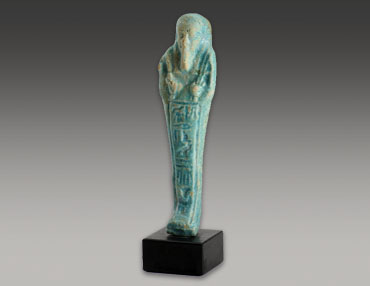
Faience Funerary Figurine
Ancient Egypt
Late Period. 3380-343 B.C.
In Ancient Egypt, death was not the end of existence. It was a crossover to the afterlife. Up until the end of the First Dynasty around 2900 BC, servants who served royalty in life were sacrificed within the tomb to continue their servitude to their dead master. However, the dynasties that followed replaced this gruesome custom with small, symbolic servants called shabti.
Shabti were ancient Egyptian funerary figurines. Each would symbolize a servant and were equipped with tools for working the fields of the Afterlife. Within the tombs of kings, dignitaries, and others, servants would place 360 of these shabti within the burial room. Each of these servants was to work in place of the deceased for one day of the year.
Early examples of these figurines were individual works of art. Some had etched upon their surface a renowned Prayer from the Book of the Dead. Others had the title and name of the deceased. Materials used in their fabrication were wood, stone, clay, terra-cotta, glass, wax, and a blue glazed earthenware called faience. By the Late Period, which began in 664 BC, shabti were being cheaply mass produced in molds for budget burials.

The specimen acquired by the museum is from the 30th Dynasty, Late Period. It was made during the reign of Nectanebo, who ruled from 380 B.C. to 343 BC. He is considered the last native Pharoah of an independent Egypt. Two decades after his reign, Egypt would fall under the empire of Alexander the Great of Macedon.
This shabti is 11 cm tall and formed in blue faience, with molded hieroglyphics down the front of the figure. The arms are crossed over its chest, with each hand holding an agricultural implement. It was acquired from a private party in Los Angeles, California. Subsequently, it was sold at auction.